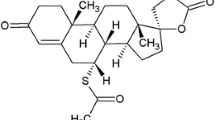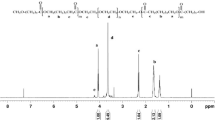Abstract
Purpose. The purpose of this study was to prepare and characterize copolymers presenting different pendant amino groups and to study their ability to form polyelectrolyte complexes with heparin. The responsiveness of the complexes to variations in pH and ionic strength was correlated to the nature of the copolymers.
Methods. Copolymers composed of different aminoethyl methacrylate monomers were synthesized by atom transfer radical polymerization (ATRP) from a poly(ethylene glycol) macroinitiator. Copolymers were characterized by gel permeation chromatography and nuclear magnetic resonance spectroscopy. Micellization properties were assessed by atomic force microscopy, multiangle static light scattering, and dynamic light scattering on complexes formed from the addition of heparin to a solution of polymer.
Results. Primary, tertiary, and quaternary amine-based diblock copolymers with molecular weights ranging from 4900 to 7400 and low polydispersity indexes were prepared. The synthesis of a copolymer bearing primary amines was achieved for the first time by ATRP. Micellization was found to be pH- and polymer-dependent. All polymers interacted with heparin at acidic pH to yield monodisperse assemblies of less than 30 nm. Complexes dissociated in response to increases in ionic strength.
Conclusions. Electrostatic interactions between the amino copolymers and heparin triggered the formation of small, monodisperse, and stable complexes that present great potential as oral drug delivery systems.
Similar content being viewed by others
REFERENCES
E. Windsor and G. E. Cronheim. Gastro-intestinal absorption of heparin and synthetic heparinoids. Nature 190:263-264 (1961).
R. H. Engel and S. J. Riggi. Effect of sulfated and sulfonated surfactants on the intestinal absorption of heparin. Proc. Soc. Exp. Biol. Med. 130:879-884 (1969).
Y-K. Lee, J. H. Nam, H-C. Shin, and Y. Byun. Coagulation of low-molecular-weight heparin and deoxycholic acid for the development of a new oral anticoagulant agent. Circulation. 104:3116-3120 (2001).
N. Sakuragawa, K. Takahashi, M. Ueno, and I. Horikoshi. Oral administration of heparin. Acta Med. Biol. 29:33-37 (1981).
R. A. Baughman, S. C. Kapoor, R. K. Agarwal, J. Kisicki, F. Catella-Lawson, and G. A. FitzGerald. Oral delivery of anticoagulant doses of heparin. A randomized, double-blind, controlled study in humans. Circulation. 98:1610-1615 (1998).
Y. Jiao, N. Ubrich, V. Hoffart, M. Marchand-Arvier, C. Vigneron, M. Hoffman, and P. Maincent. Anticoagulant activity of heparin following oral administration of heparin-loaded microparticles in rabbits. J. Pharm. Sci. 91:760-768 (2002).
Y. Jiao, N. Ubrich, M. Marchand-Arvier, C. Vigneron, M. Hoffman, T. Lecompte, and P. Maincent. In vitro and in vivo evaluation of oral heparin-loaded polymeric nanoparticles in rabbits. Circulation. 105:230-235 (2002).
K. Kataoka, A. Harada, and Y. Nagasaki. Block copolymer micelles for drug delivery: design, characterization and biological significance. Adv. Drug Deliv. Rev. 47:113-131 (2001).
A. V. Kabanov, T. K. Bronich, V. A. Kabanov, K. Yu, and A. Eisenberg. Soluble stoichiometric complexes from poly(N-ethyl-4-vinylpyridinium) cations and poly(ethylene oxide)-block-polymethacrylate anions. Macromolecules 29:6797-6802 (1996).
A. Harada, H. Togawa, and K. Kataoka. Physicochemical properties and nuclease resistance of antisense-oligonucleotides entrapped in the core of polyion complex micelles composed of poly(ethylene glycol)-poly(L-lysine) block copolymers. Eur. J. Pharm. Sci. 13:35-42 (2001).
K. Kataoka, H. Togawa, A. Harada, K. Yasugi, T. Matsumoto, and S. Katayose. Spontaneous formation of polyion complexe micelles with narrow distribution from antisense oligonucleotide and cationic block copolymer in physiological saline. Macromolecules 29:8556-8557 (1996).
Y. Kakizawa and K. Kataoka. Block copolymer micelles for delivery of gene and related compounds. Adv. Drug Deliv. Rev. 54:203-222 (2002).
A. Harada and K. Kataoka. Novel polyion complex micelles entrapping enzyme molecules in the core: preparation of narrowly-distributed micelles from lysosyme and poly(ethylene glycol)-poly(aspartic acid) block copolymer in aqueous medium. Macromolecules 31:288-294 (1998).
O. Boussif, F. Lezoualc'h, M. A. Zanta, M. D. Mergny, D. Scherman, B. Demeneix, and J-P. Behr. A versatile vector for gene and oligonucleotide transfer into cells in culture and in vivo: polyethylenimine. Proc. Natl. Acad. Sci. U. S. A. 92:7297-7301 (1995).
J. F. Kukowska-Latallo, A. U. Bielinska, J. Johnson, R. Spindler, D. A. Tomalia, and J. R. Baker, Jr. Efficient transfer of genetic material into mammalian cells using starburst polyamidoamine dendrimers. Proc. Natl. Acad. Sci. U. S. A. 93:4897-4902 (1996).
U. Rungsardthong, M. Deshpande, L. Bailey, M. Vamvakaki, S. P. Armes, M. C. Garnett, and S. Stolnik. Copolymers of amine methacrylate with poly(ethylene glycol) as vectors for gene therapy. J. Controlled Release 73:359-380 (2001).
K. A. Davis and K. Matyjaszewski. ABC triblock copolymers prepared using atom transfer radical polymerization techniques. Macromolecules 34:2101-2107 (2001).
S. Angot, D. Taton, and Y. Gnanou. Amphiphilic stars and dendrimer-like architectures based on poly(ethylene oxide) and polystyrene. Macromolecules 33:5418-5426 (2000).
V. Coessens and K. Matyjaszewski. Synthesis of polymers with amino end groups by atom transfer radical polymerization. J. Macromol. Sci. Pure Appl. Chem. A36:811-826 (1999).
K. Matyjaszewski. Mechanistic and synthetic aspects of atom transfer radical polymerization. J. Macromol. Sci. Pure Appl. Chem. A34:1785-1801 (1997).
V. Coessens, T. Pintauer, and K. Matyjaszewski. Functional polymers by atom transfer radical polymerization. Prog. Polym. Sci. 26:337-377 (2001).
M. Ranger, M-C. Jones, M-A. Yessine, and J-C. Leroux. From well-defined diblock copolymers prepared by a versatile atom transfer radical polymerization method to supramolecular assemblies. J. Polym. Sci. A: Polym. Chem. 39:3861-3874 (2001).
A. S. Lee, A. P. Gast, V. Bütün, and S. P. Armes. Characterizing the structure of pH dependent polyelectrolyte block copolymer micelles. Macromolecules 32:4302-4310 (1999).
K. Matyjaszewski, B. Göbelt, H-J. Paik, and C. P. Horwitz. Tridendate nitrogen-based ligands in Cu-based ATRP: a structure-activity study. Macromolecules 34:430-440 (2001).
M. PŠádný and S. Ševčík. Precursors of hydrophilic polymers, 3a) The potentiometric behavior of isotactic and atactic poly(2-dimethylaminoethyl methacrylate) in water/ethanol solutions. Makromol. Chem. 186:111-121 (1985).
H. M. Wang, D. Loganathan, and R. J. Linhardt. Determination of the pKa of gluronic acid and the carboxy groups of heparin by 13C-nuclear-magnetic-resonance spectroscopy. Biochem. J. 278:689-695 (1991).
A. Harada and K. Kataoka. Formation of stable and monodispersive polyion complex micelles in aqueous medium from poly(L-lysine) and poly(ethylene glycol)-poly(aspartic acid) block copolymer. J. Macromol. Sci. Pure Appl. Chem. A34:2119-2133 (1997).
A. S. Lee, V. Bütün, M. Vamvakaki, S. P. Armes, J. A. Pople, and A. P. Gast. Structure of pH-dependent block copolymer micelles: charge and ionic strength dependence. Macromolecules 35:8540-8551 (2002).
S. V. Vinogradov, T. K. Bronich, and A. V. Kabanov. Self-assembly of polyamine-poly(ethylene glycol) copolymers with phosphorothioate oligonucleotides. Bioconjug. Chem. 9:805-812 (1998).
T. W. Randolph. Phase separation of excipients during lyophilization: effects on protein stability. J. Pharm. Sci. 86:1198-1203 (1997).
N. J. Jain, V. K. Aswal, P. S. Goyal, and P. Bahadur. Salt induced micellization and micelle structures of PEO/PPO/PEO block copolymers in aqueous solution. Colloids Surf. A: Physicochem. Eng. Asp. 173:85-94 (2000).
Author information
Authors and Affiliations
Corresponding author
Rights and permissions
About this article
Cite this article
Dufresne, MH., Leroux, JC. Study of the Micellization Behavior of Different Order Amino Block Copolymers with Heparin. Pharm Res 21, 160–169 (2004). https://doi.org/10.1023/B:PHAM.0000012164.60867.c6
Issue Date:
DOI: https://doi.org/10.1023/B:PHAM.0000012164.60867.c6




